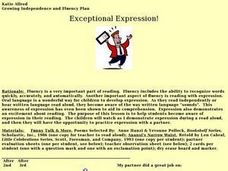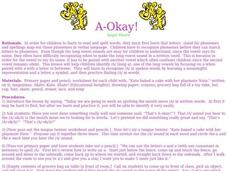Curated OER
A Little Alliteration
Second graders study rhythm, rhyme, and alliteration in poetry by completing various activities. In this language arts lesson, 2nd graders practice recognizing alliteration and then create their own poem using alliteration.
Curated OER
Letter Names
Students explore language arts by participating in a letter identification activity. In this word recognition lesson, students are shown a list of vocabulary terms which they practice reciting with their classmates. Students identify and...
Pennsylvania Department of Education
6 Traits: Voice
Students explore the trait of voice. In this language arts instructional activity, students focus on the writing trait of voice. Students view a video and practice writing.
Pennsylvania Department of Education
6 Traits: Word Choice
Students explore language arts by participating in a vocabulary usage activity. In this word choice lesson, students read examples of great word usage in literature and discuss with the class why some words appear stronger than others....
Curated OER
Language Arts, Word Choice
Third graders practice replacing words in a sentence to make it more interesting. In this word choice lesson, 3rd graders listen to the story The Hard-Times Jar by Ethel Smothers and discuss the author's word choice. Students then...
abcteach
Literature Circles Planner
Here is a literature circle worksheet for students to plan an effective group meeting. Instructions are given to answer 10 questions. This form may be used for every book the group reads.
Curated OER
I Am Special and You Are Special Too #6
We are All Alike…We Are All Different is the springboard for the creation of an illustrated book in which young writers record their impression of themselves, their families, and their interests. Sharing the completed books in circle...
Curated OER
Active and Passive Voice: Finding Examples Online
Incorporate technological fluency with a search for examples of active and passive voice in online resources. Discuss how use of active or passive voice influences mood or tone and contributes to author's purpose. List of...
Curated OER
Icky Fingers
Which i sound is used in the word icky? Kindergarteners and first graders listen to the short /i/ sound. They practice shaking their fingers to indicate icky when they hear the target sound. Then they practice reading a poster with the...
Curated OER
Exceptional Expression!
Young elementary learners develop expression while reading. They listen as the teacher demonstrates expression when reading aloud. Individual learners read with a partner and practice using expression in their reading. When their partner...
Curated OER
My Tooth is Loose
Elementary learners study the /th/ sound as a whole class. First they hear the sound and learn a tongue twister. After practicing together, they write the digraph on their practice paper. Then, to study the words in context, the class...
Curated OER
Henry Howls
Let's learn the letter h! Elementary learners will hear the sound, learn a catchy tongue twister, and identify the sound in different words the teacher says. After some writing practice, read A House for Hermit Crab, by Eric Carle,...
Curated OER
Sound of the Runners, H = /h/
A variety of activities related to the /h/ phoneme are included here. Recite an H tongue twister then trace and write the letter H. The group listens to pairs of words and identifies which word contains the /h/ sound.
Curated OER
Expression Direction: Growing Independence and Fluency
Looking to move children away from monotone reading? That's what they will practice here. In a guided learning lesson, the class reviews punctuation marks and practices what type of intonation should accompany each. They then listen...
Curated OER
Indiana Igloo
Your young charges practice identifying the /i/ sound in this instructional activity. The class looks at words on cards and identifies which word has the target sound. They continue their practice using Elkonin letterboxes to spell words...
Curated OER
Itchy Ritchy
Itchy Ritchy can help your learners remember the /i/ sound! First teach young learners the fun tongue twister illustrating the target sound, and have them identify the target sound in other words. Use the reading Tim and the Top to...
Curated OER
Astonishing "A"
Young learners gain phonemic awareness with this quick activity. First, point out what sound you’re focusing on today: /a/. Then spell basic words that use this sound, like fat, bat, cat, etc. As a culminating activity, the whole...
Curated OER
Shhhhh, She is Sleeping
The sheep on the ship was shocked by the Fish on the Shore! Can you guess which digraph we're studying? Take a look at the /sh/ sound with your young readers. Have them write words with the target sound in letter boxes, and then small...
Curated OER
Achoo!
Focus in on the digraph ch. Young readers will hear the sound, print the letters, and read A Peach for Chad. Can your youngsters think of any more words that use the target sound?
Curated OER
Open Up And Say Ahh
Who has a word that has an /o/? Teach kids this fun song (sung to the tune of "Skip to My Lou") to remember the /o/ sound and words that contain the target sound. Then have learners identify the sound in various words before...
Curated OER
A-Okay
Learners distinguish between short and long vowel /a/ sounds. They are introduced to the vowel-consonant-e pattern that changes short vowel sounds into long vowel sounds. Then they practice identifying words with the...
Curated OER
Open wide...and say Ahh!
Participate in an emerging literacy lesson that focuses on the skill of phonemic awareness! The phoneme of choice is the letter "o". They need to use letter recognition in conjunction with the sound.
Curated OER
Fresher Week Academic Vocab Bluff Game
In this grammar worksheet, students, working with a partner set up a scenario where they ask each other a set of questions as though they were entering a British Union.
Curated OER
Language Arts: Understanding Phonemes
Young scholars discover the relationship between letters and phonemes. The teacher leads an oral demonstration of pronunciation and focus on the /a/ sound. Next, students examine a series of pictures, circling the ones where they hear...

























